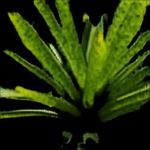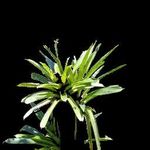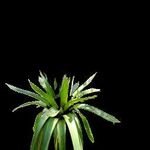ANALYSIS OF FOUR GENERATOR ARCHITECTURES OF C-GAN, LOSS FUNCTION, AND ANNOTATION METHOD FOR EPIPHYTE IDENTIFICATION
←
→
Page content transcription
If your browser does not render page correctly, please read the page content below
The International Archives of the Photogrammetry, Remote Sensing and Spatial Information Sciences, Volume XLIV-M-3-2021
ASPRS 2021 Annual Conference, 29 March–2 April 2021, virtual
ANALYSIS OF FOUR GENERATOR ARCHITECTURES OF C-GAN, LOSS FUNCTION,
AND ANNOTATION METHOD FOR EPIPHYTE IDENTIFICATION
V.V. Sajithvariyar 1,*, S Aswin1 V Sowmya 1, K.P. Soman 1, R. Sivanpillai, 2, G. K. Brown 3
1
Center for Computational Engineering and Networking, Amrita School of Engineering, Amrita Vishwa Vidyapeetham,
Coimbatore, TN 641 112, India (ORCID: 0000-0003-3944-8155) - vv_sajithvariyar@cb.amrita.edu, aswins2010@gmail.com,
v_sowmya@cb.amrita.edu, kp_soman@amrita.edu
2 Wyoming GIS Center, University of Wyoming, Laramie, WY 82072, USA (ORCID: 0000-0003-3547-9464) – sivan@uwyo.edu
3
Department of Botany, University of Wyoming, Laramie, WY 82072, USA – GKBrown@uwyo.edu
KEY WORDS: Deep Learning, GAN, Generator Network, Loss Function, SSIM, IoU
ABSTRACT:
The deep learning (DL) models require timely updates to continue their reliability and robustness in prediction, classification, and
segmentation tasks. When the deep learning models are tested with a limited test set, the model will not reveal the drawbacks. Every
deep learning baseline model needs timely updates by incorporating more data, change in architecture, and hyper parameter tuning.
This work focuses on updating the Conditional Generative Adversarial Network (C-GAN) based epiphyte identification deep learning
model by incorporating 4 different generator architectures of GAN and two different loss functions. The four generator architectures
used in this task are Resnet-6. Resnet-9, Resnet-50 and Resnet-101. A new annotation method called background removed annotation
was tested to analyse the improvement in the epiphyte identification protocol. All the results obtained from the model by changing the
above parameters are reported using two common evaluation metrics. Based on the parameter tuning experiment, Resnet-6, and Resnet-
9, with binary cross-entropy (BCE) as the loss function, attained higher scores also Resnet-6 with MSE as loss function performed
well. The new annotation by removing the background had minimal effect on identifying the epiphytes.
1. INTRODUCTION other NN algorithms are necessary for better learning and
effective utilisation of computational resources. There are many
Neural network (NN) algorithms are used in many digital data examples like introduction of different types of convolutions in
analysis (Tefas et.al., 2013). Advancements in computational convolutional NN algorithms (Ding et.al., 2018) to improve the
hardware, storage and software are fueling progress in digital feature extraction with reduced computational cost. The DL
data analysis. Deep learning-based data analysis are a part of NN architectures like Unet (Ronneberger et.al., 2015) and generative
algorithms and are robust for applications with data generated by adversarial networks (GAN) (Goodfellow et.al., 2014) are
numerous sources (Jia et.al., 2017 and Najafabadi et.al., 2015). specifically designed for image-to-image translation by
These deep learning (DL) algorithms are capable of innovative architectural components. The deep learning
understanding data and its pattern from an experiential learning algorithm updates in their components aims to produce better
and derive the features from input data and generate learned output, improved performance and effective utilization of
models (Harshvardhan et.al., 2020). The performance of DL computational resources.
algorithms are highly dependent on the quantity and quality of
data used for learning and its mathematical modelling. Shashank et.al., (2020) used Conditional-GAN algorithm (C-
GAN) introduced by Philip et.al., (2017) for identifying the
DL algorithms are used for prediction and classification tasks in epiphytes (Werauhia kupperiana) in the drone acquired images.
several disciplines (Rory et.al., 2019; Iqbal et.al., 2019). DL That study modelled the target identification task as an image-to-
algorithms consist of deep neural network components and their image translation problem and applied adversarial concepts. C-
organisation collectively referred as their architecuture. Several GAN identified 80% of the epiphytes from the test set. This study
state of the art DL architectures are used for image classification, was not able to produce good output labels in many scenarios.
object detection, and image segmentation tasks (Zhao et.al., Also, the algorithm was not able to perform well when the target
2019; Nida et.al., 2015). plant differs in distance at which target is imaged, lighting
conditions and distance at which the target is imaged. This
Performance of DL or any NN algorithms varies over time when motivated the current study to experiment and explore the
the requirements change. Changes to the structure, parameters, performance of C-GAN algorithms by changing its hyper
and mathematical modelling of DL architecture are necessary for parameters and architecture components to improve the
improving their performance. There are several DL architectures performance of the algorithm.
like VGG16, GoogleNet, ImageNet etc (Chen et al, 2018;
Szegedy et.al., 2015 and Krizhevsky et.al., 2012) used for various This study builds on the work completed by Shashank et al.
image processing applications. The DL algorithms are not self- (2020). First, a new annotation method was used for generating
adaptive to the new requirements and sometimes they are the images needed to train the algorithm. Next, the performance
computationally intensive. Hence updated concepts to DL and
* Corresponding author
This contribution has been peer-reviewed.
https://doi.org/10.5194/isprs-archives-XLIV-M-3-2021-149-2021 | © Author(s) 2021. CC BY 4.0 License. 149The International Archives of the Photogrammetry, Remote Sensing and Spatial Information Sciences, Volume XLIV-M-3-2021
ASPRS 2021 Annual Conference, 29 March–2 April 2021, virtual
four generator architectures were evaluated with two different used to remove the background pixels and retain the original,
loss functions. The objective of this study is to update the DL- true-colour image of the target plant (Figure 1). Retaining the
based epiphyte identification model used by Shashank et al., RGB values of the target plant will help C-GAN to concentrate
(2020). The proposed model underwent an architectural change more on the foreground pixel and generate better output labels.
to the existing C-GAN (Philip et.al., 2017). Results from this
study will provide valuable information for developing more 2.2 CGAN Generator and Discriminator
robust DL algorithms to identify epiphytes in digital images.
The C-GAN deep learning architecture used for epiphyte
identification consists of two competing networks called
generators and discriminator with two loss functions. The
2. MATERIALS AND METHODS
previous study used the UNET encoder-decoder architecture
The experiment were organized in two stages where binary cross (Ronneberger et.al., 2015). The encoders will map the input data
entropy (Shie et.al., 2005) was set as the loss function with 4 to a lower dimension and the decoder maps this back to original
different residual networks. In the second stage all residual information. The dimensionality reduced data will be scale
networks were coupled with MSE (Zahra et al., 2014) as the loss invariant and translation invariant which is very important for
function. The above experiments trained the C-GAN model with object identification tasks. C-GAN is a variant of GAN where it
the epiphyte dataset. The phython program trained the model for enforces the input data to derive the features based on a condition,
200 epochs and saved the final model to the local system. The which is our annotated image. This conditional enforcing will
testing was done separately with 12 images which are not seen ensure that the algorithm will focus on the target region in the
by the network during the training phase. input image by referring to the annotation images.
2.1 Epiphyte dataset and annotation In the present study, we evaluated four different types of deep
convolutional neural architecture for the generator networks. The
The epiphyte dataset used in this study was acquired in Costa following subsection gives the details of the deep neural
Rica (Sajithvariyar et.al., 2019). The epiphyte dataset consisted networks used for constructing the generator network.
of 115 drone-aquired images of which 98 were used for training,
12 for testing and remaining 5 for validation. The validation set 2.2.1 Residual Generator Networks
were used during training to tune the parameters and the test set
were used to assess the trained network’s ability to identify the The Generator networks architecture was replaced with a deep
target plant. convolutional neural architecture called Residual networks (He
et.al., 2016). The residual networks were designed by a group of
The C-GAN architecture was implemented using python and researchers in Microsoft during 2015. The major contribution of
trained in an i7 processor with 8 GB RAM and NVIDIA Quadro the network is to remove the vanishing / exploding gradient
P5000 GPU. All the input images and labels had a dimension of problem in deep networks. The residual networks are
256 x 256 x 3. implemented with shortcut connections between layers and
exhibit efficient training from residual functions as shown in
(Figure 2).
A B
C D
Figure 2. The Residual network learning residual functions by
referring input layers (He et.al., 2016).
The residual networks are designed in various layer depths and
they are named in such a way that the decimal number indicates
the layer depth. In this study we tested four different variants of
the Resnet architectures after replacing the C-GAN generator
with following variants a) Resnet-6, b) Resnet-9, c) Resnet-50,
Figure 1. The input image (A) and corresponding annotation and d) Resnet-101.
image (B) generated by the first study. The input image (C) and
the annotation image (D) generated by the present study. The generator network plays an important role in C-GAN
algorithms. The generator network is responsible for generating
The new annotation method removed the background black the fake sample by looking at the conditional parameter that is
pixels and kept the target as a true colour images. In the earlier the annotated image. The performance of generator is good when
study, the target plant was identified as red pixels (Figure 1). The it can produce fake samples as close to the original images. At
annotation images generated by Shashank et al., (2020) were this stage, the discriminator network will fail to differentiate the
This contribution has been peer-reviewed.
https://doi.org/10.5194/isprs-archives-XLIV-M-3-2021-149-2021 | © Author(s) 2021. CC BY 4.0 License. 150The International Archives of the Photogrammetry, Remote Sensing and Spatial Information Sciences, Volume XLIV-M-3-2021
ASPRS 2021 Annual Conference, 29 March–2 April 2021, virtual
original and from the fake samples. Since this study is mainly it is easy to understand the portion of the epiphyte where the
focused on the generator networks, we retained the original model failed to predict. The effect of loss function on predicted
discriminator network that was used in the previous study. The labels like blurring is evident from the annotation. This also
discriminator network is a patchGAN architecture with a patch helped to understand that the prediction on epiphyte leaf edges
size of which is the best window size experimentally proved by and overlapped leaves are more blurred.
(Isola et.al., 2017).
Replacing the generator networks with residual networks and two
Most of the studies and research in deep convolutional networks generator loss functions MSE and BCE generated different
states that “the deeper the better” (Bekele et.al., 2019). Hence we output labels. Table 1 summarizes the results obtained from 4
attempted to improve the performance of deep CNN networks by different residual networks with BCE and MSE loss functions.
adding more layers. On the other hand, by making the networks From the results obtained, generator networks with Resnet-6,
deeper the computational cost and run time will increase. The Resnet-9 and BCE as the generator loss function scored
major issue in a deep neural network is the vanishing Gradient maximum IoU and SSIM score. Also, from Table 1 it is evident
problem. This occurs when the network is not able to learn that when MSE was set as the loss function Resnet-6 generated
anything from the input data. When the network is too deep, the output labels with high SSIM and IoU score. The Resnet-50 and
gradients from the loss functions will map the values to zeros. -101 underperformed due to a smaller number of training
This will result in no further updates to the weight matrix of the samples. The deeper the networks, the more data required for
model and the learning rate of the network will decline. To training. The Resnet-50 consist of 50 layers and Resnet-101
overcome this huddle we need an architecture which is deeper consist of 101 layers, when this many layers iterate over fewer
but also free from the vanishing gradient problem. number of training samples there will not be further improvement
in training. The performance will be degraded, and the network
The residual networks enforce efficient learning by mapping will generate a poor model. This resulted in generating poor
residual functions between layers and there improve the training output labels which gives low SSIM, and IoU scores compared
process. The residual network learns the residuals to match the to ground truth.
input with the predicted weights. This process makes sure that
the deeper networks will learn better without degrading the
process.
Average SSIM and IoU score for 4 different architecture
2.3 The CGAN loss functions with BCE as loss function
Resnet-6 Resnet-9 Resnet-50 Resnet-
The loss functions are vital in any neural network training to keep 101
track of the model’s learning of the weights. The proposed SSIM 0.60 0.61 0.56 0.56
methods consist of a binary classification where the C-GAN must IoU 0.38 0.41 0.27 0.25
classify the background and target pixels. Generator loss depends Average SSIM and IoU score for 4 different architecture
on the ability of the discriminator to identify fake as real samples. with MSE as loss function
Discriminator loss penalizes itself for misclassifying a real Resnet-6 Resnet-9 Resnet-50 Resnet-
instance as fake and vice versa. In this study, we used two loss 101
functions a) Mean Squared Error (MSE) b) Binary cross Entropy SSIM 0.74 0.60 0.60 0.60
(BCE) for the generator network. The experiments were
conducted for all four generator networks with two loss IoU 0.56 0 0 0
functions. The output generated by 4 different generator Table 1. The average SSIM and IoU score computed for the
networks with two loss functions are reported using structural residual networks with two different loss functions.
similarity index (SSIM) and intersection over union score (IoU).
The SSIM scores obtained with Resnet-6 and MSE as the loss
function was higher for Resnet-6 and remained the same for the
3. RESULT AND DISCUSSION remaining networks (Table 1). These scenarios indicate the
limitations of SSIM scores for evaluating the output labels. The
The SSIM and IoU scores were computed for the predicted label SSIM score looks for the maximum similarity between the
and ground truth label from different models trained in this study. predicted and ground truth labels. In this study all label images
The SSIM will look for the structural similarity and IoU will find consisted of two classes: 1) all non-target pixels belong to
the maximum overlap between the predicted labels and ground background (black), and 2) the target pixels in its original colour
truth labels. A Python script was developed to iteratively space. Also, in many test images the target plant occupied a small
compute the IoU and SSIM score for all the test images and their area in each frame compared to background information. Under
average. these circumstances, though the model fails to correctly predict
the target plant, the similarities in the background pixels will lead
The new annotation method proposed in this study contributed to higher SSIM scores (Figure 3).
more towards the predicted label analysis for the analyst. The
new annotation images are not contributing anything new while The IoU scores associated with Resnet-6 and MSE loss function
comparing them to the annotation used in the previous study. was 0.56 (Table 1) and was 0 for the rest (Table 1). The IoU is a
This reveals that masked annotation with false color will be method to quantify the percentile of overlap between the
sufficient for epiphyte identification task. predicted label and ground truth label. IoU metric measures the
number of pixels common between the ground truth and
Analyses of the output images generated by various models prediction label divided by the total number of pixels present
trained with the new annotation method revealed no major across both labels. The value of IoU score is ranging between 0
difference in generated output labels. The major advantage for and 1 where value close to 1 indicate predicted label is closer to
analyst with the new annotation is that after predicting the labels ground truth and 0 indicate they are dissimilar.
This contribution has been peer-reviewed.
https://doi.org/10.5194/isprs-archives-XLIV-M-3-2021-149-2021 | © Author(s) 2021. CC BY 4.0 License. 151The International Archives of the Photogrammetry, Remote Sensing and Spatial Information Sciences, Volume XLIV-M-3-2021
ASPRS 2021 Annual Conference, 29 March–2 April 2021, virtual
.
Generator
A B network &
Loss
Ground Truth Predicted
function
Resnet-6
& BCE
Figure 3. The high SSIM score of an input image (A) with
minimal target occupancy and incorrectly predicted label (B)
due to high overlap between black regions.
Resnet-9
The SSIM limitations can be easily replaced while computing the & BCE
IoU score. The SSIM score is helpful when we need to evaluate
the predicted label with some epiphyte pixels and compare the
structural similarity. This shows that SSIM score along with IoU
gives a better clarity on the output labels predicted.
Results obtained from various models evaluated in this study
shows that the output predicted labels are more blurred when we
have BCE as the loss function (Table 2). The model trained with
Resnet-6 and MSE loss produce sharp images with less blurring Resnet-6
effect. The objective of the BCE loss function is to reduce the & MSE
error to zero. This results in blurring effect. Unlike BCE, MSE
computes the error based on the squared distance. This results in
less blurring effect, when compared to the output obtained using
BCE loss function.
Table 2 gives some sample output labels with high IoU and SSIM
scores predicted by Resnet-6 and 9 with BCE and Resnet-6 with Resnet-6
MSE as the loss function. & BCE
The results obtained from the experiments also reveals that when
the network is going deeper from number of layers 6 to 101 in
residual networks the SSIM and IoU scores are declined. The
deeper the networks a greater number of images is required for
training. This also shows that the potential of improving the Resnet-9
results with more training data. & BCE
4. CONCLUSIONS AND RECOMMENDATIONS
Resnet-6 and Resnet-9 with BCE and MSE loss functions were
able to generate output labels with higher SSIM and IoU scores.
The SSIM scores can be higher if the target plant occupies a small
area in the images used for testing. Resnet-50 and Resnet-101 did Resnet-6
yield output labels with lower SSIM and IoU scores due to & MSE
smaller number of images for training.
The output labels were more blurred for BCE compared to MSE
loss function. Choice of selecting appropriate loss function for
Table 2. The labels predicted by the trained model with highest
reducing the blur in the output labels. Current DL architecture
SSIM and IoU score.
demands more changes in the system loss function.
The new annotation by removing the background had no
ACKNOWLEDGEMENTS
significant improvement in label prediction.
UAV images used in this study were acquired through a seed
Incorporation of hybrid models might be necessary to make grant from the UW College of Arts & Sciences. We thank Dr.
improvements to the epiphyte identification model. This work Mario Blanco, University of Costa Rica, and Dr. Carlos de la
also highlights the opportunities for further improvement by Rosa, Director, La Selva Research Station for logistic support.
making changes to hyper parameters like loss function in addition
to incorporating new architectures.
This contribution has been peer-reviewed.
https://doi.org/10.5194/isprs-archives-XLIV-M-3-2021-149-2021 | © Author(s) 2021. CC BY 4.0 License. 152The International Archives of the Photogrammetry, Remote Sensing and Spatial Information Sciences, Volume XLIV-M-3-2021
ASPRS 2021 Annual Conference, 29 March–2 April 2021, virtual
Authors thank Dr. Poornachandran, Centre for Cyber Security Communication. doi.org/ 10.1109/ICCMC48092.2020.ICCMC-
Systems, Amritapuri Campus, Kollam, Kerala for supporting the 000173.
computational platforms. We thank Mr. Shashank Anivila for the
initial implementation of epiphyte identification model. Ronneberger, O., Fischer, P., Brox, T., 2015: U-Net:
Convolutional networks for biomedical image segmentation.
Proc. Int. Conf. Med. Image Comput. Comput.-Assist. Intervent.,
REFERENCES pp. 234-241.
Bekele, E., Lawson, W., 2019: The Deeper, the Better: Analysis Rory, P.B., Fadi, T., 2019: A machine learning framework for
of Person Attributes Recognition,14th IEEE International sport result prediction. In Applied Computing and Informatics,
Conference on Automatic Face & Gesture Recognition (FG 15(1), pp. 27-33, ISSN 2210-8327.
2019), Lille, France, pp. 1-8. doi.org/10.1109/FG.2019.8756526.
Sajithvariyar, V.V., Sowmya, V., Gopalakrishnan, E.A., Soman,
Chen, L., Zhu, L., Papandreou, G., Schroff, G., and Adam, H., K.P., Bupathy, P., Sivanpillai, R., & Brown, G.K., 2019:
2018: Encoder-decoder with atrous separable convolution for Opportunities and challenges of launching UAVs within wooded
semantic image segmentation. Proc. Eur. Conf. Comput. Vis. areas. In Proceedings of the 2019 ASPRS Annual
(ECCV), pp. 801-818. doi.org/ doi.org/10.1007/978-3-030- Conference (pp. 27-31).
01234-2_49.
Sarker, I.H., Kayes, A.S.M., Watters, P., 2019: Effectiveness
Ding-Xuan., Zhou., 2019: Universality of deep convolutional analysis of machine learning classification models for predicting
neural networks. In Applied and Computational Harmonic personalized context-aware smartphone usage. Journal of Big
Analysis. doi.org/10.1016/j.acha.2019.06.004. Data 6, 57. doi.org/10.1186/s40537-019-0219-y.
Goodfellow, I., Pouget-Abadie, J., Mirza, M., Xu, B., Warde- Shashank, A., Sajithvariyar, V. V., Sivanpillai, R., Brown, G. K.,
Farley, D., Ozair, S., Courville, A., Bengio, Y., 2014: Generative Sowmya, V.,2020: Identifying epiphytes in drone photos with a
adversarial nets. In Advances in neural information processing conditional generative adversarial network (C-GAN). In ASPRS
systems (pp. 2672-2680). doi.org/10.5555/2969033.2969125. 2020 Annual Conference Virtual Technical Program.
doi.org/10.5194/isprs-archives-XLIV-M-2-2020-99-2020.
Harshvardhan, G.M., Mahendra, K.G., Manjusha, P., Siddharth
S.R., 2020: A comprehensive survey and analysis of generative Shie, M., Dori, P., Reuven, R., 2005: The cross entropy method
models in machine learning. Computer Science Review, Volume for classification. In Proceedings of the 22nd international
38, 100285, ISSN 1574-0137, conference on Machine learning (ICML '05). Association for
doi.org/10.1016/j.cosrev.2020.100285. Computing Machinery, New York, NY, USA, 561–568.
doi.org/10.1145/1102351.1102422.
He, K., Zhang, X., Ren, S., and Sun, J., 2016: Deep residual
learning for image recognition, Proc. IEEE Conf. Comput. Vis. Szegedy, C., Liu, W., Jia, Y., Sermanet, P., Reed, S., Anguelov,
Pattern Recognition, pp. 770-778. doi.org/ D., 2015: Going deeper with convolutions. Proc. IEEE Conf.
10.1109/CVPR.2016.90 Comput. Vis. Pattern Recognit., pp. 1-9.
Isola, P., Zhu, J.Y., Zhou, T., Efros, A.A., 2017: Image-to-image Tefas A., Iosifidis A., Pitas I., 2013: Neural Networks for Digital
translation with conditional adversarial networks. In Proceedings Media Analysis and Description. In Iliadis L., Papadopoulos H.,
of the IEEE conference on computer vision and pattern Jayne C. (eds). Engineering Applications of Neural Networks.
recognition (pp. 1125-1134). doi.org/10.1109/CVPR.2017.632. Communications in Computer and Information Science, vol 383.
Springer, Berlin, Heidelberg. doi.org/10.1007/978-3-642-41013-
Jia, X., 2017: Image recognition method based on deep learning, 0_1
29th Chinese Control And Decision Conference (CCDC),
Chongqing, China, pp. 4730-4735. doi.org/ Wei, D., Zeyu, H., Zunkai, H., Li, T., Hui, W., Songlin, F., 2019:
10.1109/CCDC.2017.7979332. Designing efficient accelerator of depthwise separable
convolutional neural network on FPGA. Journal of Systems
Krizhevsky, A., Sutskever, I., Hinton, H., 2012: Imagenet Architecture, 97, Pages 278-286.
classification with deep convolutional neural networks. Proc.
Adv. Neural Inf. Process. Syst., pp. 1097-1105. Zahra, M., Essai, A., Mohamed, H., Refaee, A., 2014:
Performance Functions Alternatives of Mse for Neural Networks
Najafabadi, M.M., Villanustre, F., Khoshgoftaar, T.M., Learning. International Journal of Engineering Research &
2015. Deep learning applications and challenges in big data Technology (IJERT). 3. pp- 967.
analytics. Journal of Big Data 2, 1. doi.org/10.1186/s40537-014-
0007-7 Zhao, Z., Zheng, P., Xu, S., Wu, X., 2019: Object Detection with
Deep Learning: A Review. In IEEE Transactions on Neural
Nirmal, S., Sowmya, V., Soman K.P., 2020: Open Set Domain Networks and Learning Systems, 30(11), pp. 3212-3232.
Adaptation for Hyperspectral Image Classification Using doi.org/10.1109/TNNLS.2018.2876865.
Generative Adversarial Network. In Lecture Notes in Networks
and Systems. doi.org/10.1007/978-981-15-0146-3_78.
Patil, S.O., Sajithvariyar, V.V., Soman, K.P., 2020: Speed Bump
Segmentation an Application of Conditional Generative
Adversarial Net- work for Self-driving Vehicles. In 2020 Fourth
International Conference on Computing Methodologies and
This contribution has been peer-reviewed.
https://doi.org/10.5194/isprs-archives-XLIV-M-3-2021-149-2021 | © Author(s) 2021. CC BY 4.0 License. 153You can also read



























































